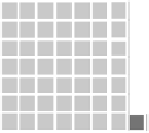Biomedical Engineering Reference
In-Depth Information
Source
Source
Capacitive
sensing
circuit
Sink
Sink
Defect-free
test outcomes
Figure 4.4
Example of a defect-free test outcome for (a) single-droplet scan-like method; and (b) parallel
scan-like method.
droplets, test droplets must be at least one electrode away from each other.
This implies that only half of the total number of columns/rows can be tested
in one parallel scan-like test iteration. Two iterations are needed to detect
defects involving single cells in the array. For defects involving two cells,
for example, shorts between two adjacent electrodes, all pairs of adjacent
electrodes must be tested. Therefore, four iterations are needed to test the
microfluidic array: two iterations for the vertically connected pairs and two
additional iterations to traverse all the horizontal connections. In addition, a
“peripheral test” is carried out before parallel scan-like testing to ensure that
a test droplet can be correctly dispensed from the source to pseudosources
and routed from pseudosinks to the sink.
The complete parallel scan-like test procedure is as follows:
Step 1. Peripheral test
: A test droplet is dispensed from the source. It
is routed to traverse all the peripheral electrodes, and the droplet
finally returns to the sink, as shown in Figure 4.5.
Step 2. Column test
: Two iterations of parallel scan-like test with one
column shift are carried out. This step tests every single cell and
all “edges” (pairs of adjacent cells) in each column. Therefore, it is
referred to as “column test.”
Step 3. Row test:
Repeat parallel scan-like test (two iterations) for the
rows to detect defects involving pairs of adjacent cells in each row.
This step is referred to as “row test.”
We next use a 6 × 6 array as an example. A total of three test droplets
(6/2 = 3) are dispensed and routed in each parallel scan-like test itera-
tion. The various steps in the test application procedure are shown in
Figures 4.5-4.7.
In order to achieve defect tolerance via reconfiguration, a diagnosis method
is needed to locate faulty cells. We do not attempt to identify the defect type


































